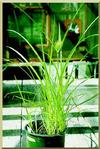|
The following conclusions are derived from this study:
- The Ojos Negros valley is infested with the coquillo weed. The infestation is moderate to severe, with 11 affected parcels,
and the extent of infestation varying from 10 to 30 percent, often in patches. Yellow nutsedge (Cyperus esculentus L.) predominates over
purple nutsedge (Cyperus rotundus L.) as the primary species.
- The presence of coquillo in the valley appears to correlate well with the presence of the green onion crop and the associated
practice of renting the land to the agricultural companies.
Both crop and weed established themselves in the valley at about the same time, 6 to 10 yr ago.
- Coquillo likes plenty of sunlight and water. Shading inhibits the growth of coquillo; irrigation
favors the development of coquillo.
- Coquillo is difficult to control by mechanical or chemical means. The tubers can grow to depths up to 1 m,
making it next to impossible to dispose by mechanical extraction. Selective harvest of the aerial parts
will not control the coquillo, because the tubers will hide underground and resprout when water becomes available.
- Coquillo can be controlled by cultural means, e.g., by rotation to a taller plant such as alfalfa, or by resting the land
for a few years. Coquillo can also be temporarily controlled by weeding, although at a high cost to the farmer.
- Coquillo may also be controlled by alternative means
such as soil solarization and feed for pigs, and it may be grown commercially for use as food for wildlife, particularly wild turkes and cranes.
- The yellow nutsedge of the Sativus variety is used in other parts of the world as food for humans.
The variety is successfully cultivated in Valencia, Spain, and other selected regions such as Egypt, Italy, and Argentina.
Particularly, the tubers are grounded and used in the production of a beverage called horchata de chufas, which has a pleasant flavor of
vanilla and almonds. Other uses for the tubers such as for ice cream and coffee and chocolate substitutes have been documented.
- The cultivation of coquillo in the Ojos Negros valley holds promise.
This is also true in the case of the neighboring valleys of Baja California, particularly Maneadero and
Trinidad, where the coquillo infestation is judged to be presently more severe than in Ojos Negros.
The tubers can be marketed for use in the preparation of horchata and for other economic uses, following established
practice in other parts of the world.
- The cultivation of coquillo
will require a change of perception on the part of farmers, government officials, and other actors,
to regard the coquillo less as a weed and more as a crop from which economic benefit can be obtained.
Additional research in this area is highly recommended, due to its potential for sustainability.
|

